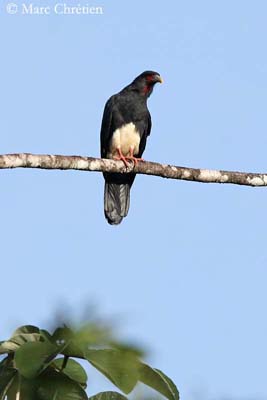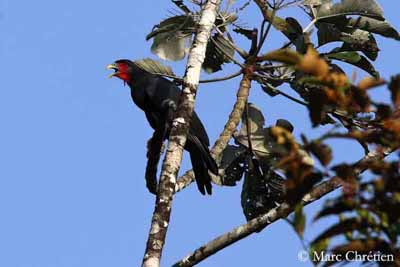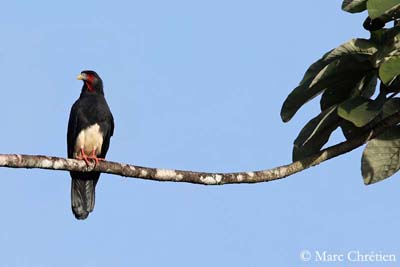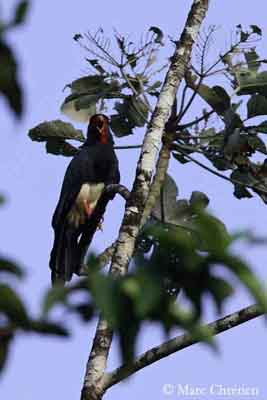
Red-throated Caracara
Daptrius americanus
Falconiforme Order – Falconidae Family
BIOMETRICS:
Length: 48-61cm
Wingspan: 97-115 cm
Weight: 510-680 g
DESCRIPTION:
The Red-throated Caracara occurs in dense forest. It is the largest of the three Amazon species.

Adult male has glossy black plumage on the upperparts, including wings and tail.
On the underparts, belly, thighs and undertail coverts are white.
On the head, forehead, crown and nape are glossy black. Face and throat show red bare skin. The bill is pale yellowish with blue-grey cere. Eyes are dark red to brown. Legs and feet are red.
Both sexes are similar.
The immature has rather yellowish bare skin on face and throat than adults.
VOICE: SOUNDS BY XENO-CANTO
The Red-throated Caracara is often very noisy. It utters a strange raucous carrying call “cowh-cah-cowh” or “ah-ah-ah-aou”. We can also hear a longer series of “cow-cow-cow-cacow”. In flight, it gives a throaty “rrrah”. At some distance, these sounds may suggest several macaws.
The calls are accompanied by nodding of the head and alternate wing beats. Vocalizations maintain the cohesion within the group.
HABITAT:
The Red-throated Caracara frequents the humid evergreen forests and their edges, and clearings with scattered trees, up to 500 to 700 metres of elevation.
RANGE:
The Red-throated Caracara lives from the extreme south of Mexico, southwards to Colombia and north and north-east of South America, to southern Brazil.

BEHAVIOUR:
The Red-throated Caracara is gregarious, often seen flying in small noisy flocks through the canopy. It also flies low and may be seen even on the ground.
It perches on treetops along the forest edges or streams. When in dense forest, it perches lower or on the ground.
The Red-throated Caracara feeds mainly on wasp and bee larvae and eggs. It also takes the hard palm fruits, varied invertebrates and turtle eggs.
Most of the birds feed in understorey, attacking the smaller bee and wasp nests, while two birds remain in the canopy, probably as sentinels.

The bare skin of face and throat allows these birds to take the prey into the wasp’s colony. Usually, the wasps never attack the birds, and stay about one metre away from the Red-throated Caracaras, suggesting that these birds have a kind of repellent which protects them.
Other birds’ species take advantage of the Caracara’s group for safety and they follow the flocks during long time.
FLIGHT:
The Red-throated Caracara does not soar but it flies with slow, deep wing beats. Its flight may be laboured, performed with much flapping.
REPRODUCTION:
The Red-throated Caracara has a complex social structure within the group, not so common in birds of prey. There is a hierarchy in the small group. Often two birds are required as sentinels and guard the nest-site aggressively. Usually, the other members of the group feed these sentinels.
These birds are very territorial and remain for long time (about five years) in the same territory. They are sedentary and defend it all year round. These aggressive displays are accompanied by loud calls.
The sentinels take turns at nest. When a member of the group brings a wasp nest, one of the sentinels leaves the nest-site for feeding, while the last arrived replaces it. Four birds may be seen delivering food at nest.
The breeding season varies according to the range, the latitude, the altitude and the food resources. The Red-throated Caracara’s nest is made with sticks and situated in tree. It is often hidden in dense vegetation.
The female lays 2 or 3 white of buff eggs with brown spots.
The nesting behaviour of this species is poorly known, but these birds practise communal nest-guarding and nesting duties, that are uncommon behaviour in Falconidae.
Usually, the pair-bonds last all the year in these sedentary birds.

DIET:
The Red-throated Caracara feeds mainly on wasp and bee eggs and larvae, and attacks the smallest nests. It also feeds on hard fruits, turtle eggs and several species of invertebrates.
PROTECTION / THREATS / STATUS:
The populations of this species have declined in some parts of the range, due to deforestation. The Red-throated Caracara forages in the understorey, and prefers mature, high forests with closed canopy. This fact may explain some decrease due to deforestation, because this bird cannot feed easily in secondary or disturbed forests.
However, the species is not globally threatened at this moment.
Fr: Caracara à gorge rouge
All : Rotkehlkarakara
Esp : Caracara Gorgirrojo
Ital : Caracara golarossa
Nd : Roodkeelcaracara
Russe : Краснозобая каракара
Port : Gralhão
Photographs by Marc Chrétien
His website :
MURINUS
Text by Nicole Bouglouan
Sources :
A GUIDE TO THE BIRDS OF MEXICO AND NORTHERN CENTRAL AMERICA by Steve N. G. Howell, Sophie Webb - Oxford University Press - ISBN: 0198540124
A GUIDE TO THE BIRDS OF COLOMBIA by Steven L. Hilty and William L. Brown
Princeton University Press – ISBN 069108372X
HANDBOOK OF THE BIRDS OF THE WORLD Vol 2 by Josep del Hoyo-Andrew Elliot-Jordi Sargatal - Lynx Edicions - ISBN: 8487334156
Biodiversity - Ecuador - Land of Megadiversity